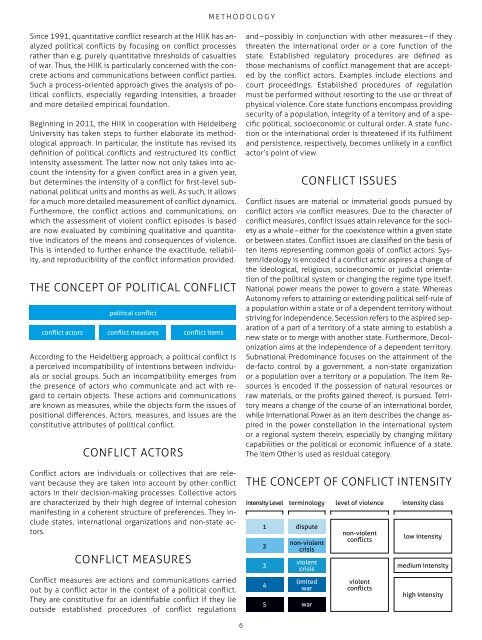ConflictBarometer_2015
ConflictBarometer_2015
ConflictBarometer_2015
Create successful ePaper yourself
Turn your PDF publications into a flip-book with our unique Google optimized e-Paper software.
Since 1991, quantitative conflict research at the HIIK has analyzed<br />
political conflicts by focusing on conflict processes<br />
rather than e.g. purely quantitative thresholds of casualties<br />
of war. Thus, the HIIK is particularly concerned with the concrete<br />
actions and communications between conflict parties.<br />
Such a process-oriented approach gives the analysis of political<br />
conflicts, especially regarding intensities, a broader<br />
and more detailed empirical foundation.<br />
Beginning in 2011, the HIIK in cooperation with Heidelberg<br />
University has taken steps to further elaborate its methodological<br />
approach. In particular, the institute has revised its<br />
definition of political conflicts and restructured its conflict<br />
intensity assessment. The latter now not only takes into account<br />
the intensity for a given conflict area in a given year,<br />
but determines the intensity of a conflict for first-level subnational<br />
political units and months as well. As such, it allows<br />
for a much more detailed measurement of conflict dynamics.<br />
Furthermore, the conflict actions and communications, on<br />
which the assessment of violent conflict episodes is based<br />
are now evaluated by combining qualitative and quantitative<br />
indicators of the means and consequences of violence.<br />
This is intended to further enhance the exactitude, reliability,<br />
and reproducibility of the conflict information provided.<br />
THE CONCEPT OF POLITICAL CONFLICT<br />
conflict actors<br />
political conflict<br />
conflict measures<br />
According to the Heidelberg approach, a political conflict is<br />
a perceived incompatibility of intentions between individuals<br />
or social groups. Such an incompatibility emerges from<br />
the presence of actors who communicate and act with regard<br />
to certain objects. These actions and communications<br />
are known as measures, while the objects form the issues of<br />
positional differences. Actors, measures, and issues are the<br />
constitutive attributes of political conflict.<br />
CONFLICT ACTORS<br />
Conflict actors are individuals or collectives that are relevant<br />
because they are taken into account by other conflict<br />
actors in their decision-making processes. Collective actors<br />
are characterized by their high degree of internal cohesion<br />
manifesting in a coherent structure of preferences. They include<br />
states, international organizations and non-state actors.<br />
CONFLICT MEASURES<br />
conflict items<br />
Conflict measures are actions and communications carried<br />
out by a conflict actor in the context of a political conflict.<br />
They are constitutive for an identifiable conflict if they lie<br />
outside established procedures of conflict regulations<br />
and – possibly in conjunction with other measures – if they<br />
threaten the international order or a core function of the<br />
state. Established regulatory procedures are defined as<br />
those mechanisms of conflict management that are accepted<br />
by the conflict actors. Examples include elections and<br />
court proceedings. Established procedures of regulation<br />
must be performed without resorting to the use or threat of<br />
physical violence. Core state functions encompass providing<br />
security of a population, integrity of a territory and of a specific<br />
political, socioeconomic or cultural order. A state function<br />
or the international order is threatened if its fulfilment<br />
and persistence, respectively, becomes unlikely in a conflict<br />
actor’s point of view.<br />
CONFLICT ISSUES<br />
Conflict issues are material or immaterial goods pursued by<br />
conflict actors via conflict measures. Due to the character of<br />
conflict measures, conflict issues attain relevance for the society<br />
as a whole – either for the coexistence within a given state<br />
or between states. Conflict issues are classified on the basis of<br />
ten items representing common goals of conflict actors: System/Ideology<br />
is encoded if a conflict actor aspires a change of<br />
the ideological, religious, socioeconomic or judicial orientation<br />
of the political system or changing the regime type itself.<br />
National power means the power to govern a state. Whereas<br />
Autonomy refers to attaining or extending political self-rule of<br />
a population within a state or of a dependent territory without<br />
striving for independence, Secession refers to the aspired separation<br />
of a part of a territory of a state aiming to establish a<br />
new state or to merge with another state. Furthermore, Decolonization<br />
aims at the independence of a dependent territory.<br />
Subnational Predominance focuses on the attainment of the<br />
de-facto control by a government, a non-state organization<br />
or a population over a territory or a population. The item Resources<br />
is encoded if the possession of natural resources or<br />
raw materials, or the profits gained thereof, is pursued. Territory<br />
means a change of the course of an international border,<br />
while International Power as an item describes the change aspired<br />
in the power constellation in the international system<br />
or a regional system therein, especially by changing military<br />
capabilities or the political or economic influence of a state.<br />
The item Other is used as residual category.<br />
THE CONCEPT OF CONFLICT INTENSITY<br />
intensity Level<br />
2<br />
3<br />
4<br />
violent<br />
crisis<br />
limited<br />
war<br />
5 war<br />
terminology level of violence intensity class<br />
1 dispute<br />
non-violent<br />
crisis<br />
non-violent<br />
conflicts<br />
violent<br />
conflicts<br />
low intensity<br />
medium intensity<br />
high intensity<br />
6


